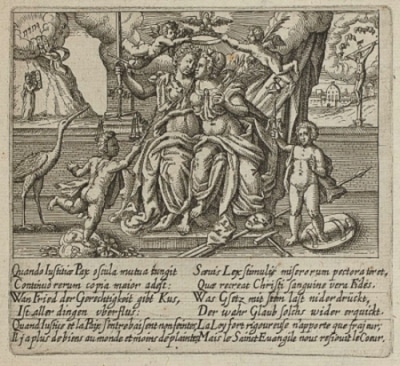Just like the declaration of war, the conclusion of peace also required clarification, communication and justification beyond the actual text of the peace treaty. This task was performed by representations of peace, which were something of a multimedia phenomenon in their day. They took many forms ranging from visual depictions (such as paintings or works of architecture) and verbal imagery (such as commemorative publications or sermons) to musical forms (such as songs and festive music). All of these representations of peace drew upon a shared canon of motifs, allegories and topoi that were used and comprehended throughout Europe, meaning they could be aimed at different publics.
As part of the joint project ‘Righteousness and Peace Kiss Each Other – Representations of peace in early modern Europe’ led by the Institut für Europäische Geschichte (Leibniz Institute of European History, IEG) in Mainz, researchers at the HAB examined peace poetry (Friedensdichtungen) situated between lyrical utopia and political pragmatism. This three-year project involving doctoral and post-doctoral researchers carried out in cooperation with the Universität Göttingen analysed scholarly poetry as a genre reflecting on the semantics of peace artistically and descriptively. Peace poems were often written to celebrate peace or to accompany public appearances by political actors. They contain several levels of imagery that are significant for communicating and legitimising peace agreements. The project examines, compiles and analyses poetic texts from the 16th to early 18th century written in Latin or German and referring to historical peace treaties. The independently published material held by the HAB forms the basis for the project; other dependent publications are also included through the examination of printed matter relating to peace treaties as well as printed editions of poetic works. The project primarily seeks to study the literary conceptualisation of peace and, furthermore, determine how problems relating to politics and religion were addressed in peace treaties. Additionally, the project looks at the linguistic means that were used to communicate particular ideals and what long-term options for promoting peace are outlined in the poems. This cooperative in-depth cataloguing of the corpus of sources relating to different representations of peace was carried out according to the standards of the Semantic Web using the project platform WissKI.
A cooperative project between the Herzog August Bibliothek and the IEG
PURL: http://diglib.hab.de/?link=070
Funding: Leibniz-Gemeinschaft
Duration: September 2015 – August 2018
Project participants: Prof. Ulrike Gleixner (contact), Franziska Bauer (team member), Prof. Marian Füssel (Göttingen) (dissertation project supervisor)

